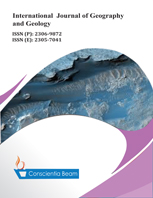Improving the Geological Understanding of the Niger Delta Basin of Nigeria Using Airborne Gravity Data
DOI:
https://doi.org/10.18488/journal.10/2016.5.5/10.5.97.103Abstract
Airborne gravity anomaly over parts of Niger delta basin of Nigeria has been interpreted qualitatively and quantitatively. The residual anomaly was obtained from the observed field data through a second order polynomial method and then enhanced by a filtering process. The qualitative interpretation of the gridded data reveals NS, EW and NE-SW trending subsurface structures. The inverse and forward modeling results show spherical and dyke-like anomaly structures at depths of between 1,090 m to 3,538 m, while the density contrast of formations identifies areas of possible hydrocarbon occupation. The Euler deconvolution windowed solutions reveal depth to anomalous sources of between 2,000 m to 9,300 m for structural index of one, and depths of between 3,200 m to 10,600 m for structural index of two. The source parameter imaging reveals depth ranges of between 1,700 m to 10,600 m. The work reveals that the maximum depth to basement in the study area is 10,600 m.

